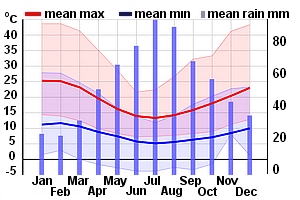Jump to Winery List
Limestone Coast Wine Region
The Limestone Coast Wine Zone was officially classified in 1996, and a number of separate
regions have been recognised including Padthaway, Coonawarra, Wrattonbully, Robe, and Mt Benson.
The wineries around Penola and Mt Gambier have also established a separate
identities without being formally recognised as regions.
The Zone includes the section of land south and east of the Coorong, and the inland
town of Keith to the border with Victoria. The Limestone Coast produces about
30 percent of all bottle quality wine produced in South Australia.
Much of the wine produced is exported to many countries.
The Limestone coast benefits from a unique set of geological and climatic features,
which combined with the skills, knowledge and experience of the winemakers, sets the
foundation for the unique wines produced from the area.The limestone base for the
soils is a unique feature of the landscape.The limestone was formed from the residue of
the rich marine life in sediments left behind during past sea level rises that inundated the area. The climate of Limestone Coast region shows continental and maritime influences that are well suited for growing cool climate wines. Most of the vineyards are located inland from the coast.. The highest elevation vineyard is at about 90 m above sea level in the Naracoorte Range, and lowest is about 10m (near Cape Jaffa). The vineyards are cooled by afternoon sea breezes during summer and the cool, slow ripening conditions creates fruit with intense flavours with unique and complex qualities. There is considerable variability is the soils and climate throughout the zones in the various regions.
The Limestone Coast Wine Region includes nine districts :
Padthaway ;
Robe ;
Wrattonbully ;
Kingston SE ;
Mount Gambier ;
Mount Benson ;
Lucindale ;
Bordertown
Coonawarra


Search for a Winery
- Balnaves of Coonawarra, SA
- Baudin Rock Wines, SA
- BLOK Estate, SA
- BordertownVineyard, SA
- Bowen Estate, SA
- Brand's Laira Coonawarra, SA
- Browns, SA
- Cape Jaffa Wines, SA
- Caroline Hills Wines, SA
- Coonawarra Jack Winery, SA
- DiGiorgio Family Wines, SA
- Eight at the Gate, SA
- Elgin Valley, SA
- Farmers Leap Wines, SA
- Flanagans Ridge, SA
- Flint's of Coonawarra, SA
- Glenhurst Vineyards, SA
- Haig Vineyards, SA
- Henry's Drive, SA
- Herbert Vineyard, SA
- Highbank Wines, SA
- Hollick Wines, SA
- Howcroft Estate, SA
- Jack Estate, SA
- Karatta Wines, SA
- Katnook Estate, SA
- Koonara Wines, SA
- LCW Corp - Limestone Coast Wines, SA
- Lucindale Area School, SA
- Lucindale Vineyard, SA
- M Chapoutier, SA
- Majella Wines, SA
- Morambro Creek, SA
- Norfolk Rise, SA
- Padthaway Estate, SA
- Parker Estate Coonawarra, SA
- Patrick of Coonawarra, SA
- Pavy Wines, SA
- Pepper Tree Wines, SA
- Punters Corner, SA
- Raidis Estate, SA
- Ralph Fowler, SA
- Redden Bridge Wines, SA
- Redman Wines, SA
- Robe Town Brewery, SA
- Robe Vineyard, SA
- Rymill Coonawarra, SA
- Stoney Rise, SA
- Tapanappa wines, SA
- Treasury Wine Estates - Penfolds , SA
- Wangolina Station, SA
- Winetrust Estates, SA
- Wirrega Vineyards, SA
- Wolf Blass, SA
- Woodsoak Wines, SA
- Wynns Coonawarra Estate, SA
- Zema Estate, SA
No Match for Your Search